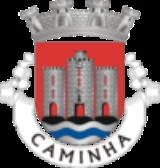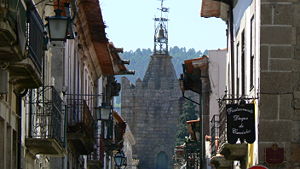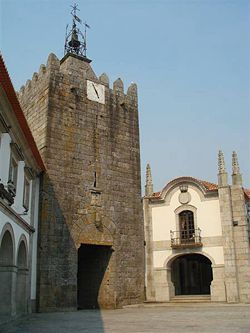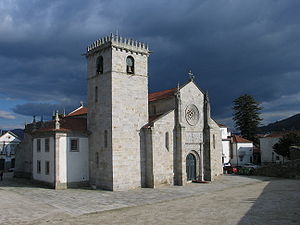
Caminha
Encyclopedia
Caminha is a municipality in the north-west of Portugal
, 21 km north from Viana do Castelo, located in the Viana do Castelo District.
The municipality has a total area of 137.4 km² and 16,839 inhabitants (2006).
Caminha is subdivided into 20 parishes, among them Vila Praia de Âncora, Moledo, and Vilar de Mouros
. The latter is well-known for the oldest rock festival in Portugal. The seat of the municipality is the town (or vila in Portuguese
) of Caminha, with 2,500 inhabitants.
The present Mayor is Júlia Paula Pires Pereira da Costa, elected by the Social Democratic Party
.
The municipal holiday is Easter Monday
.
, on the southern side of the Minho
estuary, where this river is met by the smaller and meandering Coura. Here the Minho reaches its widest point (about 2 km) and marks the border between Portugal and Spain
. The highly scenic area, with the wide estuary marked by low-tide sandbars, a pastoral and green rural landscape, and pine forests on the slopes of the granitic mountains is increasingly popular for second homes and as a summer resort.

n docks in the mouth of the Minho, no further evidence was found. An islet
at the confluence of the Minho and Coura, now connected to the mainland, was the site of a small Roman
military settlement. Caminha was called Camenae or Camina during the period of Sueve domination in the 5th century. The area was depopulated due to Arab
and Norman
raids, and slowly reoccupied after the 10th century. Around 1060, during the reign of Ferdinand I of León
, Caminha was briefly a county
and it is known that a castle existed in the area.
In the 13th century, Caminha was just a fishing village until King Afonso III
decided to build a modern castle and a fortified village following the bastide model, finished in 1260. At that time, the region was of great military importance, since it was located at the border with Galicia. The castle was later reinforced by Kings Dinis I, when reclaimed land finally connected the original island to the shore, and Ferdinand I
. Although most of the walls and towers were torn down or built over, the oval shape of the castle is still clearly visible in the design of some streets, and the keep
tower is still intact and serves as entrance to the historical centre. The pinewood of Camarido, stabilizing the sandbars at the mouth of the Minho, was another important initiative of Dinis I.
The first letter of feudal rights (foral
) dates from 1284. Caminha belonged to the crown until King Ferdinand I
established in 1371 the County of Caminha, whose first count was Álvaro Pires de Castro. In 1390, King John I granted much freedom to the town (creating a póvoa marítima), leading maritime commerce to flourish. In the 15th and 16th centuries, it became one of the main ports in Northern Portugal, trading extensively with Northern Europe, Africa and India. A witness of this golden age is the main church (Igreja Matriz), built between the 15th and 16th centuries in an exuberant late Gothic
-Renaissance
mixed style. King Manuel I
granted Caminha a new foral
in 1512. King Manuel also rebuilt the Ínsua Fort (Forte da Ínsua), located in an island at sea and close to the village of Moledo.
 After Portugal regained its independence from Spain in 1640, King John IV
After Portugal regained its independence from Spain in 1640, King John IV
remodeled the fortifications of Caminha following modern ballistic advances. The Ínsua Fort was also remodeled. Together with the fortifications of Viana do Castelo, Valença
, and Monção
, the castle of Caminha was part of the defence line against the Castilians
in the North.
With time, Caminha was superseded by Viana do Castelo in dominating maritime trade in Northern Portugal. Now Caminha lives from trade and tourism and it is connected to Spain by a car ferry and to the rest of the country by rail and highways.
to Renaissance
in Portugal, with Manueline
influence. Several architects from Northern Spain participated in its long construction. The outstanding timber roof in the interior has rich decoration showing Moorish influences (Mudéjar
style).
Other major points of interest include the main square (Renaissance fountain of 1551), several Gothic and Renaissance houses in the old core and main square, and remains of medieval and 17th century fortifications. Some pre-Roman archeological findings and ethnographic pieces are shown in the modest Municipal Museum.
The marshes along the Coura are protected and good for birdwatching.
The Atlantic beaches in the area are wide and have good sand but tend to be windy for part of the day; the Moledo beach (4 km south) attracts surfers. River and sea excursions can be arranged with local fishermen.
South of the Coura, the small granitic range ("Serra") of Arga (823 m) provides ample opportunities for hiking, cyclocross and canyoning. In the wooded northern slopes is the small monastery of S. João de Arga (popular place for picnics, camping and exploring peaks and streams; also venue for a religious festival) and the village of Castanheira (scenic terraced fields and natural pools).
A weekly market is held every Wednesday. Work from local coppersmiths and lacemakers can be found around town.


Portugal
Portugal , officially the Portuguese Republic is a country situated in southwestern Europe on the Iberian Peninsula. Portugal is the westernmost country of Europe, and is bordered by the Atlantic Ocean to the West and South and by Spain to the North and East. The Atlantic archipelagos of the...
, 21 km north from Viana do Castelo, located in the Viana do Castelo District.
The municipality has a total area of 137.4 km² and 16,839 inhabitants (2006).
Caminha is subdivided into 20 parishes, among them Vila Praia de Âncora, Moledo, and Vilar de Mouros
Vilar de Mouros
Vilar de Mouros is a civil parish in the municipality of Caminha, Portugal. Located on the banks of the Coura, 7 km from the municipal seat, it became famous as the location of the oldest rock festival in Portugal - the Vilar de Mouros Festival....
. The latter is well-known for the oldest rock festival in Portugal. The seat of the municipality is the town (or vila in Portuguese
Portuguese language
Portuguese is a Romance language that arose in the medieval Kingdom of Galicia, nowadays Galicia and Northern Portugal. The southern part of the Kingdom of Galicia became independent as the County of Portugal in 1095...
) of Caminha, with 2,500 inhabitants.
The present Mayor is Júlia Paula Pires Pereira da Costa, elected by the Social Democratic Party
Social Democratic Party (Portugal)
The Social Democratic Party , is a centre-right liberal conservative political party in Portugal. It is commonly known by its initials, PSD; on ballot papers, its initials appear as PPD/PSD, with the first three letters coming from the party's original name, Democratic People's Party...
.
The municipal holiday is Easter Monday
Easter Monday
Easter Monday is the day after Easter Sunday and is celebrated as a holiday in some largely Christian cultures, especially Roman Catholic and Eastern Orthodox cultures...
.
General information
Caminha is located 2 km from the Atlantic OceanAtlantic Ocean
The Atlantic Ocean is the second-largest of the world's oceanic divisions. With a total area of about , it covers approximately 20% of the Earth's surface and about 26% of its water surface area...
, on the southern side of the Minho
Minho River
The Minho or Miño is the longest river in Galicia, Spain, with an extension of 340 km.Both names come from Latin Minius...
estuary, where this river is met by the smaller and meandering Coura. Here the Minho reaches its widest point (about 2 km) and marks the border between Portugal and Spain
Spain
Spain , officially the Kingdom of Spain languages]] under the European Charter for Regional or Minority Languages. In each of these, Spain's official name is as follows:;;;;;;), is a country and member state of the European Union located in southwestern Europe on the Iberian Peninsula...
. The highly scenic area, with the wide estuary marked by low-tide sandbars, a pastoral and green rural landscape, and pine forests on the slopes of the granitic mountains is increasingly popular for second homes and as a summer resort.

History
Despite Strabo reference to PhoeniciaPhoenicia
Phoenicia , was an ancient civilization in Canaan which covered most of the western, coastal part of the Fertile Crescent. Several major Phoenician cities were built on the coastline of the Mediterranean. It was an enterprising maritime trading culture that spread across the Mediterranean from 1550...
n docks in the mouth of the Minho, no further evidence was found. An islet
Islet
An islet is a very small island.- Types :As suggested by its origin as islette, an Old French diminutive of "isle", use of the term implies small size, but little attention is given to drawing an upper limit on its applicability....
at the confluence of the Minho and Coura, now connected to the mainland, was the site of a small Roman
Hispania
Another theory holds that the name derives from Ezpanna, the Basque word for "border" or "edge", thus meaning the farthest area or place. Isidore of Sevilla considered Hispania derived from Hispalis....
military settlement. Caminha was called Camenae or Camina during the period of Sueve domination in the 5th century. The area was depopulated due to Arab
Arab
Arab people, also known as Arabs , are a panethnicity primarily living in the Arab world, which is located in Western Asia and North Africa. They are identified as such on one or more of genealogical, linguistic, or cultural grounds, with tribal affiliations, and intra-tribal relationships playing...
and Norman
Normans
The Normans were the people who gave their name to Normandy, a region in northern France. They were descended from Norse Viking conquerors of the territory and the native population of Frankish and Gallo-Roman stock...
raids, and slowly reoccupied after the 10th century. Around 1060, during the reign of Ferdinand I of León
Ferdinand I of León
Ferdinand I , called the Great , was the Count of Castile from his uncle's death in 1029 and the King of León after defeating his brother-in-law in 1037. According to tradition, he was the first to have himself crowned Emperor of Spain , and his heirs carried on the tradition...
, Caminha was briefly a county
County
A county is a jurisdiction of local government in certain modern nations. Historically in mainland Europe, the original French term, comté, and its equivalents in other languages denoted a jurisdiction under the sovereignty of a count A county is a jurisdiction of local government in certain...
and it is known that a castle existed in the area.
In the 13th century, Caminha was just a fishing village until King Afonso III
Afonso III of Portugal
Afonso III , or Affonso , Alfonso or Alphonso or Alphonsus , the Bolognian , the fifth King of Portugal and the first to use the title King of Portugal and the Algarve, from 1249...
decided to build a modern castle and a fortified village following the bastide model, finished in 1260. At that time, the region was of great military importance, since it was located at the border with Galicia. The castle was later reinforced by Kings Dinis I, when reclaimed land finally connected the original island to the shore, and Ferdinand I
Ferdinand I of Portugal
Ferdinand I , sometimes referred to as the Handsome or rarely as the Inconstant , was the ninth King of Portugal and the Algarve, the second son of Peter I and his wife, Constance of Castile...
. Although most of the walls and towers were torn down or built over, the oval shape of the castle is still clearly visible in the design of some streets, and the keep
Keep
A keep is a type of fortified tower built within castles during the Middle Ages by European nobility. Scholars have debated the scope of the word keep, but usually consider it to refer to large towers in castles that were fortified residences, used as a refuge of last resort should the rest of the...
tower is still intact and serves as entrance to the historical centre. The pinewood of Camarido, stabilizing the sandbars at the mouth of the Minho, was another important initiative of Dinis I.
The first letter of feudal rights (foral
Foral
thumb|left|200px|Foral of Castro Verde - PortugalThe word foral derives from the Portuguese word foro, ultimately from Latin forum, equivalent to Spanish fuero, Galician foro, Catalan furs and Basque foru ....
) dates from 1284. Caminha belonged to the crown until King Ferdinand I
Ferdinand I of Portugal
Ferdinand I , sometimes referred to as the Handsome or rarely as the Inconstant , was the ninth King of Portugal and the Algarve, the second son of Peter I and his wife, Constance of Castile...
established in 1371 the County of Caminha, whose first count was Álvaro Pires de Castro. In 1390, King John I granted much freedom to the town (creating a póvoa marítima), leading maritime commerce to flourish. In the 15th and 16th centuries, it became one of the main ports in Northern Portugal, trading extensively with Northern Europe, Africa and India. A witness of this golden age is the main church (Igreja Matriz), built between the 15th and 16th centuries in an exuberant late Gothic
Gothic architecture
Gothic architecture is a style of architecture that flourished during the high and late medieval period. It evolved from Romanesque architecture and was succeeded by Renaissance architecture....
-Renaissance
Renaissance
The Renaissance was a cultural movement that spanned roughly the 14th to the 17th century, beginning in Italy in the Late Middle Ages and later spreading to the rest of Europe. The term is also used more loosely to refer to the historical era, but since the changes of the Renaissance were not...
mixed style. King Manuel I
Manuel I of Portugal
Manuel I , the Fortunate , 14th king of Portugal and the Algarves was the son of Infante Ferdinand, Duke of Viseu, , by his wife, Infanta Beatrice of Portugal...
granted Caminha a new foral
Foral
thumb|left|200px|Foral of Castro Verde - PortugalThe word foral derives from the Portuguese word foro, ultimately from Latin forum, equivalent to Spanish fuero, Galician foro, Catalan furs and Basque foru ....
in 1512. King Manuel also rebuilt the Ínsua Fort (Forte da Ínsua), located in an island at sea and close to the village of Moledo.

John IV of Portugal
|-|John IV was the King of Portugal and the Algarves from 1640 to his death. He was the grandson of Catherine, Duchess of Braganza, who had in 1580 claimed the Portuguese crown and sparked the struggle for the throne of Portugal. John was nicknamed John the Restorer...
remodeled the fortifications of Caminha following modern ballistic advances. The Ínsua Fort was also remodeled. Together with the fortifications of Viana do Castelo, Valença
Valença, Portugal
Valença is a city in Valença Municipality, Portugal. It is a half-castle and half-land city. Bordering Galicia, Valença is also a famous Portuguese landmark to view an ancient castle town. These two parts of this city are not separated from each other and is also near to Viana Do Castelo....
, and Monção
Monção
Monção is a municipality in Portugal with a total area of 211.3 km² and a total population of 19,738 inhabitants .The municipality is composed of 33 freguesias , and is located in the district of Viana do Castelo....
, the castle of Caminha was part of the defence line against the Castilians
Kingdom of Castile
Kingdom of Castile was one of the medieval kingdoms of the Iberian Peninsula. It emerged as a political autonomous entity in the 9th century. It was called County of Castile and was held in vassalage from the Kingdom of León. Its name comes from the host of castles constructed in the region...
in the North.
With time, Caminha was superseded by Viana do Castelo in dominating maritime trade in Northern Portugal. Now Caminha lives from trade and tourism and it is connected to Spain by a car ferry and to the rest of the country by rail and highways.
Attractions
The large Parish Church (begun 1488) is one of the most significant buildings illustrating the transition from GothicGothic architecture
Gothic architecture is a style of architecture that flourished during the high and late medieval period. It evolved from Romanesque architecture and was succeeded by Renaissance architecture....
to Renaissance
Renaissance
The Renaissance was a cultural movement that spanned roughly the 14th to the 17th century, beginning in Italy in the Late Middle Ages and later spreading to the rest of Europe. The term is also used more loosely to refer to the historical era, but since the changes of the Renaissance were not...
in Portugal, with Manueline
Manueline
The Manueline, or Portuguese late Gothic, is the sumptuous, composite Portuguese style of architectural ornamentation of the first decades of the 16th century, incorporating maritime elements and representations of the discoveries brought from the voyages of Vasco da Gama and Pedro Álvares Cabral...
influence. Several architects from Northern Spain participated in its long construction. The outstanding timber roof in the interior has rich decoration showing Moorish influences (Mudéjar
Mudéjar
Mudéjar is the name given to individual Moors or Muslims of Al-Andalus who remained in Iberia after the Christian Reconquista but were not converted to Christianity...
style).
Other major points of interest include the main square (Renaissance fountain of 1551), several Gothic and Renaissance houses in the old core and main square, and remains of medieval and 17th century fortifications. Some pre-Roman archeological findings and ethnographic pieces are shown in the modest Municipal Museum.
The marshes along the Coura are protected and good for birdwatching.
The Atlantic beaches in the area are wide and have good sand but tend to be windy for part of the day; the Moledo beach (4 km south) attracts surfers. River and sea excursions can be arranged with local fishermen.
South of the Coura, the small granitic range ("Serra") of Arga (823 m) provides ample opportunities for hiking, cyclocross and canyoning. In the wooded northern slopes is the small monastery of S. João de Arga (popular place for picnics, camping and exploring peaks and streams; also venue for a religious festival) and the village of Castanheira (scenic terraced fields and natural pools).
A weekly market is held every Wednesday. Work from local coppersmiths and lacemakers can be found around town.


Parishes
- Âncora
- Arga de Baixo
- Arga de Cima
- Arga de São João
- Argela
- Azevedo
- Caminha (or Caminha-Matriz) (Caminha)
- Cristelo
- Dem
- Gondar
- Lanhelas
- Moledo
- Orbacém
- Riba de Âncora
- Seixas
- Venade
- Vila Praia de Âncora
- Vilar de MourosVilar de MourosVilar de Mouros is a civil parish in the municipality of Caminha, Portugal. Located on the banks of the Coura, 7 km from the municipal seat, it became famous as the location of the oldest rock festival in Portugal - the Vilar de Mouros Festival....
- Vilarelho (Caminha)
- Vile
Population
| Population of Caminha municipality (1801 – 2004) | ||||||||
|---|---|---|---|---|---|---|---|---|
| 1801 | 1849 | 1900 | 1930 | 1960 | 1981 | 1991 | 2001 | 2004 |
| 9,251 | 12,167 | 15,288 | 15,810 | 16,688 | 15,883 | 16,207 | 17,069 | 16,926 |

